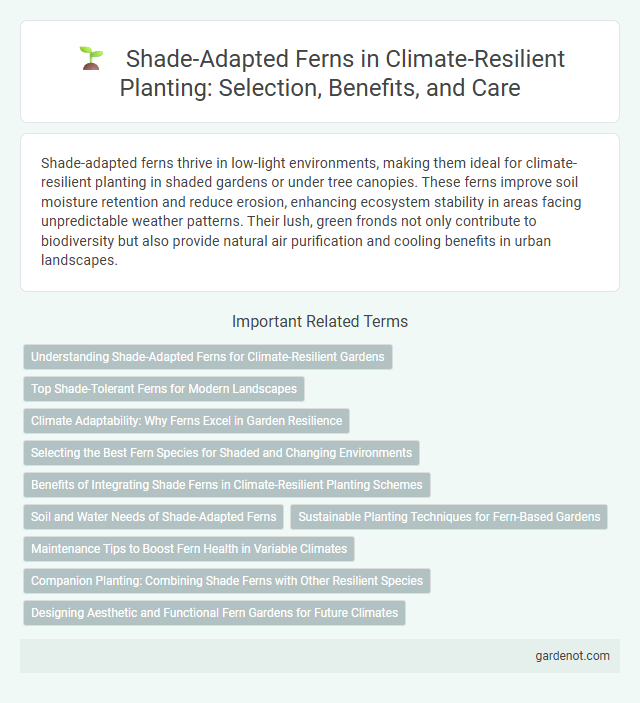Shade-adapted ferns thrive in low-light environments, making them ideal for climate-resilient planting in shaded gardens or under tree canopies. These ferns improve soil moisture retention and reduce erosion, enhancing ecosystem stability in areas facing unpredictable weather patterns. Their lush, green fronds not only contribute to biodiversity but also provide natural air purification and cooling benefits in urban landscapes.
Understanding Shade-Adapted Ferns for Climate-Resilient Gardens
Shade-adapted ferns thrive in low-light environments by utilizing efficient photosynthesis processes suited for shaded conditions, making them ideal for climate-resilient gardens. These ferns improve soil moisture retention and reduce heat stress through their dense, moisture-holding fronds, enhancing garden microclimates. Integrating shade-adapted ferns supports biodiversity and resilience by providing habitat for shade-dependent species and stabilizing under-canopy ecosystems amid changing climate patterns.
Top Shade-Tolerant Ferns for Modern Landscapes
Top shade-tolerant ferns such as the Japanese Painted Fern (Athyrium niponicum) and the Autumn Fern (Dryopteris erythrosora) offer exceptional climate resilience for modern landscapes by thriving in low-light conditions while requiring minimal water. These shade-adapted ferns contribute to soil stabilization and biodiversity, making them ideal for sustainable garden designs in areas with limited sunlight. Their ability to withstand temperature fluctuations and shaded microclimates ensures long-term plant health and landscape durability.
Climate Adaptability: Why Ferns Excel in Garden Resilience
Shade-adapted ferns demonstrate exceptional climate adaptability by thriving in low-light, humid environments typical of shaded garden areas. Their deep root systems and ability to retain moisture enhance soil stability and reduce erosion, contributing significantly to garden resilience against climate extremes. These ferns' tolerance to temperature fluctuations and drought conditions makes them a sustainable choice for climate-resilient landscaping.
Selecting the Best Fern Species for Shaded and Changing Environments
Selecting the best shade-adapted fern species for climate-resilient planting involves prioritizing ferns with proven tolerance to low light and fluctuating moisture levels, such as the Japanese Painted Fern (Athyrium niponicum) and the Christmas Fern (Polystichum acrostichoides). These species exhibit robust adaptability to shaded and changing microclimates, ensuring sustained growth amid variable climate conditions. Emphasizing native and regionally suited ferns enhances ecosystem stability and supports biodiversity in evolving shaded landscapes.
Benefits of Integrating Shade Ferns in Climate-Resilient Planting Schemes
Shade-adapted ferns enhance climate-resilient planting schemes by improving soil moisture retention and reducing surface temperature through their dense canopy. Their ability to thrive in low-light environments helps maintain biodiversity and supports ecosystem stability under changing climate conditions. Integrating shade ferns also aids in carbon sequestration and erosion control, contributing to sustainable landscape management in vulnerable areas.
Soil and Water Needs of Shade-Adapted Ferns
Shade-adapted ferns thrive in well-drained, consistently moist soil enriched with organic matter to retain adequate hydration without waterlogging. These ferns require shaded or partially shaded environments where soil moisture can be maintained through regular watering and mulching, promoting healthy root development. Optimal water management and nutrient-rich substrates enhance their resilience to fluctuating microclimates and support sustainable growth in shaded landscapes.
Sustainable Planting Techniques for Fern-Based Gardens
Shade-adapted ferns thrive under low-light conditions, making them ideal for sustainable planting techniques in fern-based gardens that prioritize water efficiency and soil health. Incorporating native shade-adapted ferns such as Dryopteris marginalis helps reduce maintenance and supports local biodiversity by providing habitat and erosion control. Employing mulching and organic compost enhances moisture retention and nutrient availability, ensuring resilient growth in climate-stressed environments.
Maintenance Tips to Boost Fern Health in Variable Climates
Shade-adapted ferns thrive in moist, well-drained soil enriched with organic matter to maintain consistent hydration and nutrient availability. Regular mulching around the base preserves soil moisture and regulates temperature fluctuations, essential for variable climates. Pruning dead fronds and monitoring for pests ensure the fern's vigorous growth and resilience against environmental stressors.
Companion Planting: Combining Shade Ferns with Other Resilient Species
Shade-adapted ferns thrive in low-light environments, making them ideal companions for other shade-tolerant, climate-resilient species such as hostas and astilbes. These ferns enhance soil moisture retention and improve microclimate stability, supporting overall plant health and drought resistance. Integrating shade-adapted ferns within companion planting schemes fosters biodiversity and strengthens ecosystem resilience against climate stressors.
Designing Aesthetic and Functional Fern Gardens for Future Climates
Shade-adapted ferns such as the Western sword fern (Polystichum munitum) and the Japanese painted fern (Athyrium niponicum) thrive in low-light, moist environments, making them ideal for climate-resilient garden designs. These ferns provide lush, textured foliage that enhances aesthetic appeal while improving humidity retention and soil stability in shaded areas vulnerable to climate stresses. Integrating diverse shade-tolerant fern species supports microclimate regulation and promotes biodiversity, ensuring functional and sustainable gardens under future climate conditions.
Shade-adapted fern Infographic

 gardenot.com
gardenot.com